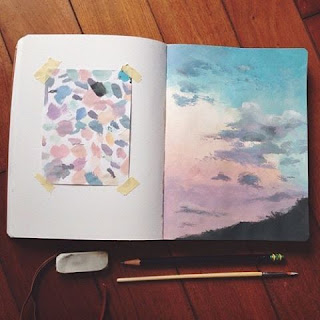Applying Paint In Art Journals
Craft paints are the perfect medium for your journals. First thing to know about craft paints is that they dry very quickly. If you are on hard for any reason, cover your paint with a piece of plastic wrap.
One of the best thing about craft paint in art journals is that the cost of these paints is very reasonable. If you watch the box craft stores, you can often find them on sale. Just a few drops will go far in covering your pages.
Another feature is that you can write on the paint once it is dry. Since it dries fairly quickly, you can be sure that you will be able to get on with your pages quickly
You will also find that when you use craft paints on your art journal pages, the pages will tend not stick together. If you have any stickiness, you can either place a sheet of waxed paper between your pages. Another alternative is to put a very light dusting of baby powder on a dry painted page.
Using Craft Paints In Art Journals Quick Tips
- Shake the paint before using
- Use very little paint on the blending tool
- Swirl the paint on a craft mat to spread the paint
- When working in an art journal, use a very light touch going in one direction
- Use a piece of wax paper under the page you are working on so that none of the paint will get on other pages
- Clean your stencil right away using a paper towel
- Black and white can be added to anything but go very lightly
- Always use a foam pad to add paint over ink
- Stay in the same color family
- Use the paint from the lid
- Use an old gift card or credit card to apply and smooth paint on the paper
- If you ate using different colors, and cleaning your brushes, make sure to blot them dry with paper towels
- Craft paints dry quickly, but you can also use a heat gun on a very low setting 6-8 inches from the surface to speed up the process.
- Use gesso as a base for any thin journal pages. The paint will not bleed through the other side and will be less likely to tear
- Use a palette knife to create texture on the paint on your page.


Comments
Post a Comment
We would love to hear your thoughts, ideas, or just say hello. We appreciate your time here today. Thank you for stopping by!